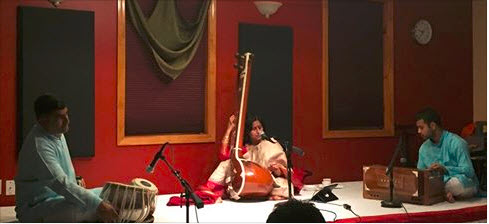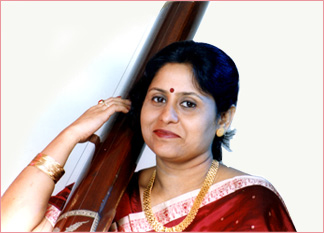Contribute
| Mitali Banerjee Bhawmik's Soulful Renditions Of Hindustani Classical Music |
Shuchita Rao
10/14/2015
It is not often that one comes across a vocalist who is equally adept at singing classical as well as semi-classical genres of Hindustani Music. New Jersey based Vidushi Smt. Mitali Banerjee Bhawmik regaled listeners in Boston with a soulful rendition of offerings in Hindustani Khyaal, Thumri, Tappa, Dadra, Chaiti, Tarana and Kabir Bhajan on the evening of September 26. The ragas presented were Anandi Kalyan, Gaud Malhar, Bageshri, Kaafi, Pilu and Bhairavi. The renowned tabla player Shri Suryaksha Deshpande on tabla and Shri Rohan Prabhudesai on harmonium provided sensitive support to the vocalist in an engaging three hour long program organized by Learnquest Baithak. Vidushi Smt. Bhawmik, endowed with a powerful voice that spans multiple octaves with ease possesses the ability to touch the hearts of listeners with her rich imagination and her uncanny command on sur, laya and bhaav. Her training in music started at an early age from Sri Ajit Dutta, followed by extensive training from Late Shree Biren Phukan in Guwahati, Assam. Subsequently, she received training from Vidushi Smt. Meera Banerjee, the noted Kolkata based vocalist. In 1984, she became the disciple of late Padmabhushan Pandit V. G. Jog, the famous violin maestro, studying with him for more than two decades. Currently she is expanding her repertoire in semi-classical (Thumri, Dadra, Kajri, Chaiti, Hori, etc.) music under the guidance of Smt. Dahlia Rahut, a senior disciple of the queen of Purab Ang style of thumri singing, Smt. Girija Devi. An active and sought after performer, she has sung for Mira Nair’s acclaimed movie “Namesake†and is a well-respected teacher to a large number of students who attend her New Jersey based school Ethnomedia Music Studio. She is also affiliated with the New York based Chhandayan School of Music. Q. You have learned music from several teachers, having spent the longest time training with the great violinist Padmabhushan Pandit V. G. Jog. What unique perspectives to music did you gain by training for two decades under an instrumentalist rather than a vocalist? A. All my teachers were wonderful. While I learned about tonality and vocal techniques such as how to throw my voice from my vocal teachers, I gained invaluable insight into understanding the personality and movements of ragas from Guruji, Pandit V.G Jog. My Guruji had learned music from both a vocalist, the legendary Dr. S. N. Ratanjankar, principal of Bhatkhande College of Hindustani Music as well as from the great instrumentalist Baba Allaudin Khan. He had the distinction of accompanying several great vocalists such as Vidushi Smt. Hirabai Barodekar and Vidushi Smt. Manik Varma among many others and had the renowned vocalist Pandit K.G. Guinde for his best friend. He was both a great performer and teacher and was very detailed and systematic in his approach. He had many students but gave individual attention to each student. I studied with him for five years in Kolkatta and accompanied him to listen to concerts at Sangeet Research Academy in Kolkatta. My training with him continued after my marriage and relocation to US as he stayed at my home whenever he visited from India. . Because of his experience as an accompanist to vocalists of different schools of music (gharanas), he could explain to me how vocalists treat a specific raga and use different phrases and note patterns in different gharanas. That was the uniqueness of the instruction I received from him. Q. You sing multiple genres of Hindustani music such as Khyaal, Thumri, and Dadra with equal ease. At the Learnquest Baithak concert, you sang a tappa as well as thumri in 16 beat cycle addha teentaal. Listeners have also often heard Khyaal being sung in addha teentaal rhythm cycle. In other words, khyaal, thumri, tappa and perhaps other genres can be performed in the framework of a single taala and tempo. How would you describe the difference in musical architecture and approach to development of these separate genres? A. In Thumri, the emphasis is on showing emotion(bhaav) through lyrics of the poem. Usually, I sing it in a slow (vilambit) tempo in Jat taal but I chose to sing it in a faster tempo in addha teentaal at Learnquest Baithak because I had sung slow tempo pieces earlier in the program and did not want to introduce yet another piece in slow tempo. The musical phrases employed in Tappa singing are heavily dependent on intricate taan (fast melodic sequences) patterns. A little bit of “tappa ang†can be used while singing Thumri, but it must be used sparingly as the emphasis in thumri is on showing emotion (bhaav) through effective use of lyrics. The fast “laggi†section at the end of thumri where the accompanists get an opportunity to show their skills is unique to thumri genre. Thumri development is also different from how one develops a khyaal, where the emphasis is on ragadaari (showing movement of the raga). Q. You have collaborated several times with Carnatic musicians for concerts in New Jersey, USA. What was that experience like? What did you find to be similar and what did you find to be different about the twin systems of music? A. I have collaborated with multiple Carnatic musicians at public concerts in US. The choice of presentation was always a raga common to both Hindustani and Carnatic music systems. We had excellent dialogs with each other when it came to developing ragas. I found Carnatic musicians very thorough in aspect of rhythm and taal. When it came to singing taans (fast melodic sequences), I found that Hindustani taan patterns differed a little bit. I could also choose to sing in different speeds in one single taan whereas the Carnatic vocalists stuck to one single speed in a given taan – either single tempo or double tempo. Overall, it was an enjoyable experience to collaborate with Carnatic musicians. Q. You have been teaching music for several years. What aspect of classical music appeals to the younger generation? How do you engage students to stick and stay with learning classical music? A. Good music, rich in melody that touches the heart attracts every generation all over the world. It takes time for interest in music to grow in the minds of young children. There are no short-cuts. I work at arranging attractive musical pieces for them – recently, I put together compositions in ragas Bhimpalasi and Sarang for them which they really liked singing. Over time, when young students see their peers performing with confidence in front of appreciative audience, they feel motivated to work hard. I feel very happy to see them grow in music and pray to GOD that I show them the right direction. Q. You are married to a talented playwright. Have you thought of collaborating together on a musical project? A. My husband Sudipto has written and presented several plays, some of which have been translated into multiple Indian languages. He has approached me for giving music to his theatre productions but it is a challenging task to give appropriate music for different scenes in a play. It may be a good idea for me to collaborate with him if he decides to write a play about a biographical character such as Mirabai. Q. How do you manage to balance your responsibilities as a musician, mother, daughter, wife and teacher? A. It is hard work. My older son Shiladitya is studying at Wharton College and my younger son Omkar is studying at Rutgers University. I run a non-profit institution Raag Rang that promotes Indian Classical music and matters related to that are always at the back of my mind. I teach music in the evenings but the “day†is mine and I practice music all day. I listen to music and sometimes even practice at night after finishing teaching music. All along my journey, my mother has been very invested in my growth as a musician. Till today, even though she lives in India, she wants to know how my riyaaz and performances are going. Q. Are you happy with taking up music as a profession? What are the challenges and rewards of such a career? A. I am happy to be a professional musician. There are plenty of challenges mainly related to marketing one’s talent, networking and finding opportunities. I enjoy performing and sing from my heart. When that reaches the hearts of listeners, I feel satisfied. A good comment from a musician means more than dollars to me.
Here are excerpts of an interview with Smt. Mitali Bhawmik about her background and experiences as a performer-teacher.
You may also access this article through our web-site http://www.lokvani.com/

